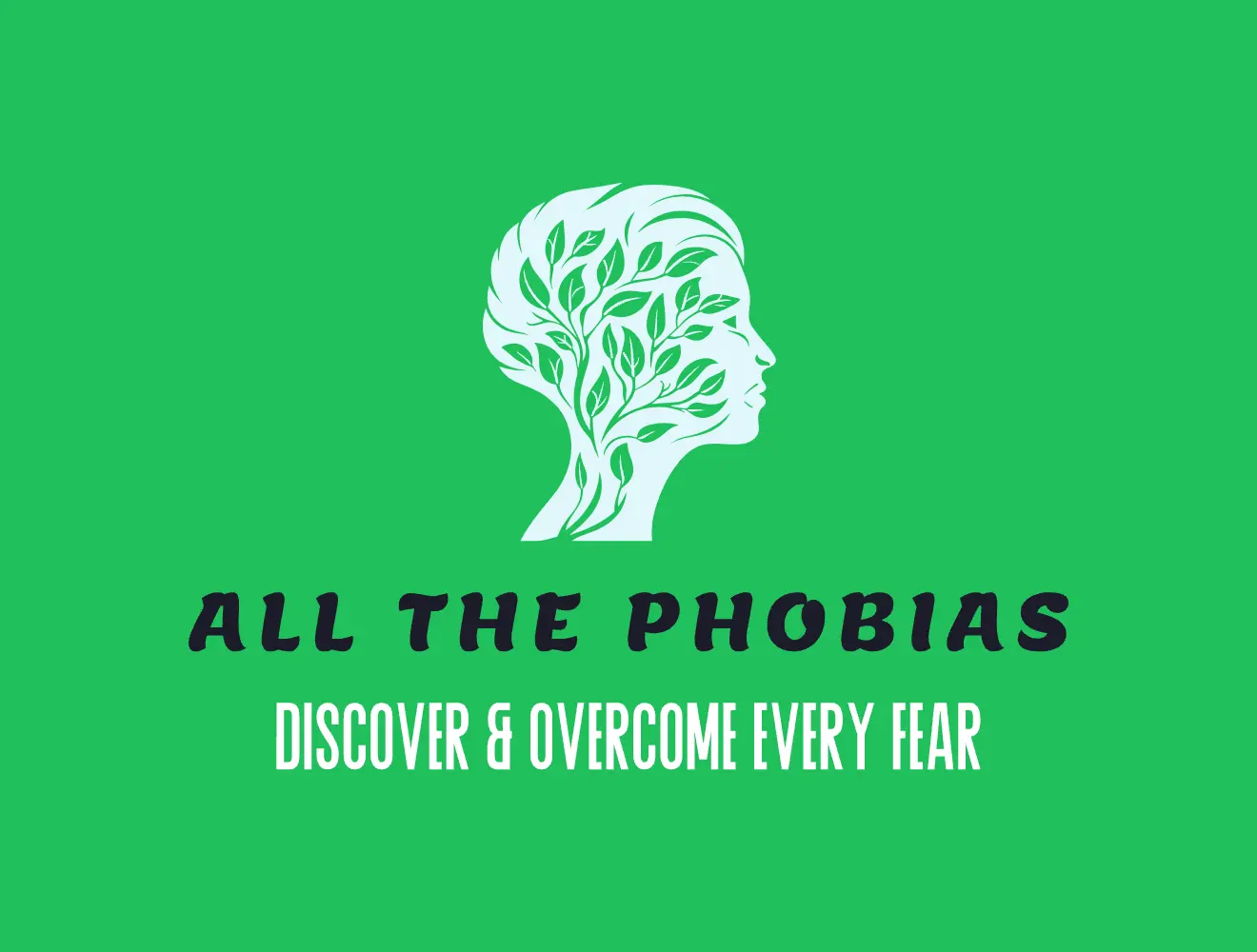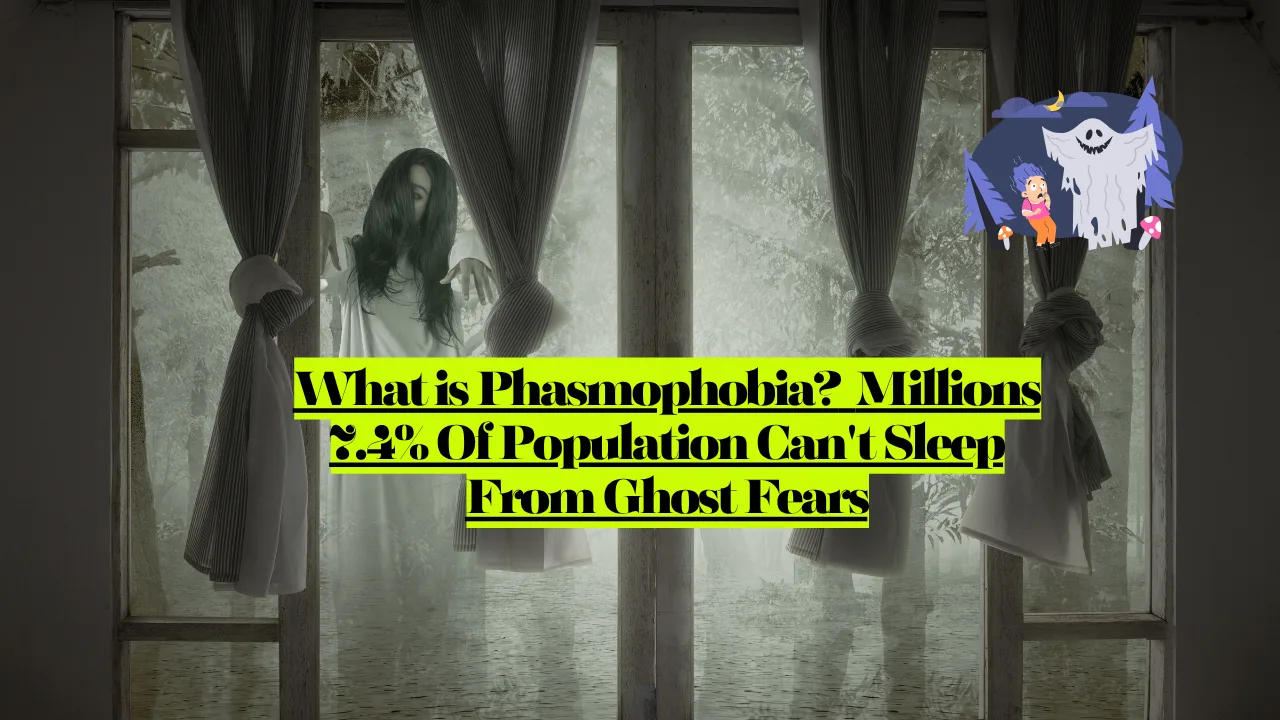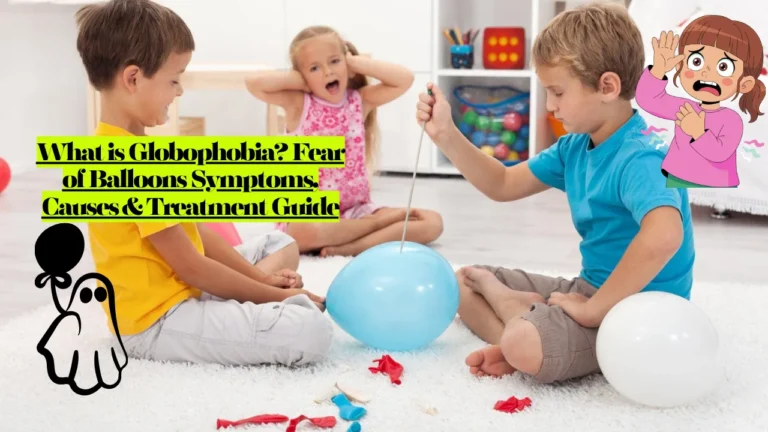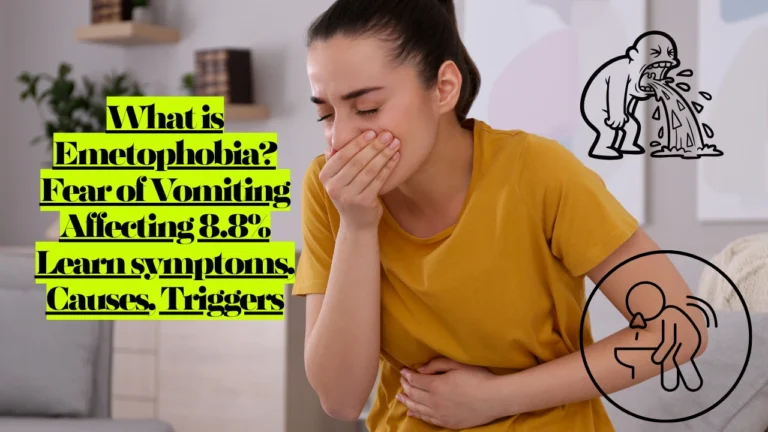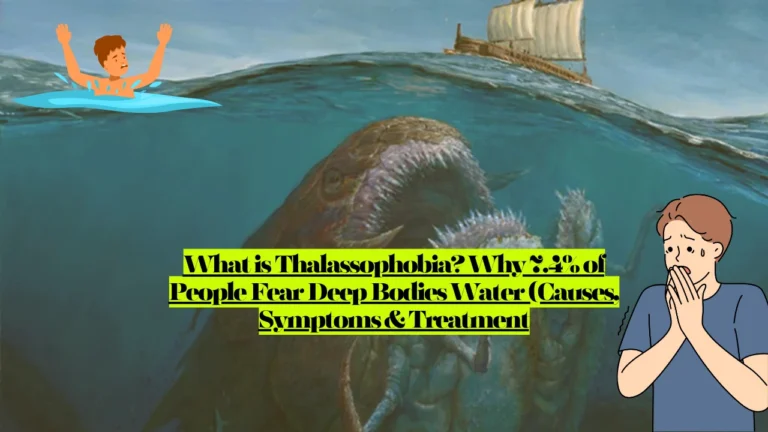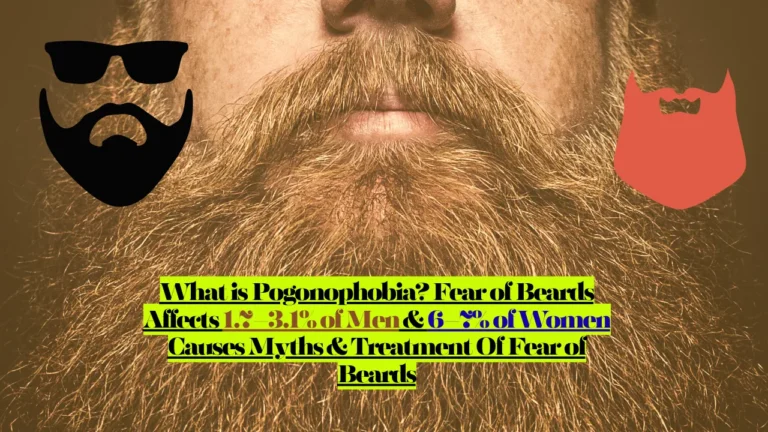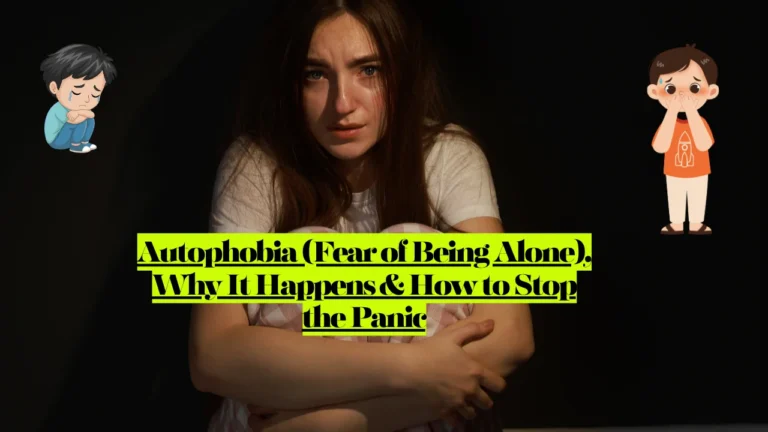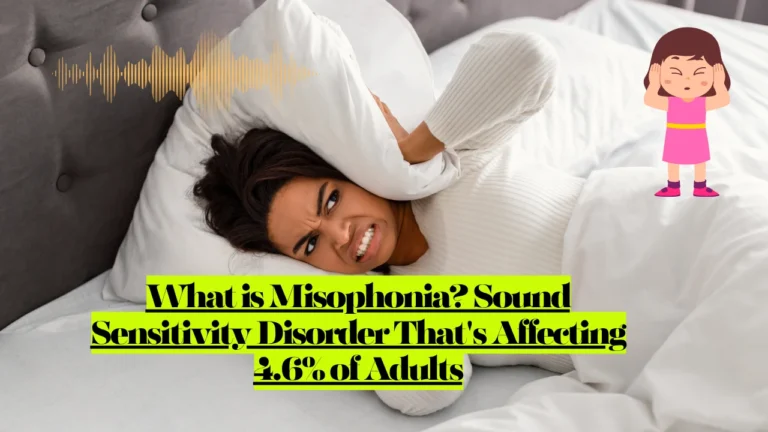Phasmophobia is an intense, persistent fear of ghosts, spirits, or supernatural entities that significantly interferes with daily life. If you’re experiencing overwhelming anxiety when thinking about ghosts, avoiding places you believe might be haunted, or having panic attacks triggered by supernatural themes, you’re likely dealing with this specific phobia.
Here’s what you need to know right away:
- It affects approximately 7.4% of the population with specific phobias, making ghost-related fears among the more common supernatural phobias (The Lancet Psychiatry, 2018)
- It’s a recognized psychological condition, not just “being scared” – it’s classified in the DSM-5 under Specific Phobias
- Effective treatments exist with 80-90% success rates for specific phobias when using evidence-based approaches like Cognitive Behavioral Therapy (Journal of Anxiety Disorders, 2023)
- You can overcome this fear with the right professional guidance and treatment approach
At AllThePhobias.com, we’ve compiled the most current research and professional insights to help you understand and address phasmophobia. This comprehensive guide covers everything from recognizing symptoms to finding effective treatment options.
Do You Have Phasmophobia? Key Signs to Look For
Physical Symptoms When Encountering Ghost-Related Content
When exposed to ghost-related triggers, people with phasmophobia commonly experience:
- Rapid heartbeat and chest tightness – Your heart may race or pound intensely
- Sweating and trembling – Excessive perspiration, especially in hands and forehead
- Shortness of breath or hyperventilation – Feeling like you can’t get enough air
- Nausea and stomach upset – Digestive distress or feeling sick to your stomach
- Dizziness or feeling faint – Lightheadedness that may lead to fear of fainting
- Muscle tension and shaking – Involuntary trembling or rigid muscle responses
According to the American Anxiety and Depression Association, these physical symptoms occur because your nervous system activates the “fight-or-flight” response even when there’s no real danger present.
Related phobia: Autophobia (Fear of Being Alone), Why It Happens & How to Stop the Panic

Emotional & Mental Responses
The psychological symptoms of phasmophobia include:
- Overwhelming dread or terror when thinking about ghosts
- Intrusive thoughts about supernatural encounters
- Anticipatory anxiety about potentially encountering ghost-related content
- Feeling of losing control during exposure to triggers
- Irrational thoughts despite knowing fears may be unrealistic
Severity Scale: Mild phasmophobia might cause discomfort when watching horror movies, while severe cases can trigger full panic attacks from simply hearing ghost stories or seeing supernatural imagery.
Behavioral Changes and Avoidance Patterns
People with phasmophobia often display these behavioral changes:
- Avoiding horror movies, books, or TV shows with supernatural themes
- Refusing to visit historical sites or locations with alleged hauntings
- Sleep disruptions – difficulty sleeping alone or in dark rooms
- Checking behaviors – repeatedly checking locks, closets, or dark areas
- Social limitations – avoiding friends’ houses or social events in certain locations
- Travel restrictions – refusing to stay in older hotels or historic buildings
Clinical Significance: When these avoidance behaviors significantly impact your work, relationships, or quality of life, it indicates the fear has reached clinical levels requiring professional attention.
Phasmophobia: Myths vs. Reality
Common Myths Debunked
Myth: “It’s just being scared—everyone’s afraid of ghosts” Reality: Phasmophobia is a clinical condition causing panic attacks and life disruption. Normal fear doesn’t prevent you from going to work, sleeping, or maintaining relationships.

Myth: “You just need to face your fear and get over it” Reality: Forced exposure without proper guidance can worsen the phobia. Professional treatment using gradual, controlled exposure is necessary for lasting recovery.
Myth: “Only children have this fear” Reality: While phobias often start in childhood (average age 7), adults can develop phasmophobia after traumatic experiences, high-stress periods, or grief-related triggers.
Myth: “People with phasmophobia actually believe in ghosts” Reality: Many people with this phobia logically know ghosts aren’t real, but their brain’s fear response activates anyway. Knowing something isn’t rational doesn’t stop the physical symptoms.
Myth: “It will go away on its own” Reality: Untreated phobias typically persist or worsen. Studies show 10-30% last for decades without intervention, but 80-90% improve with proper treatment.
Myth: “You need medication to treat it” Reality: Medication isn’t first-line treatment. Cognitive Behavioral Therapy and exposure therapy are most effective, though medication may help severe cases temporarily.
Myth: “If you have this phobia, you’re weak or irrational” Reality: Phobias are neurological conditions involving overactive fear-processing brain regions. Seeking treatment shows strength, not weakness.
Myth: “Avoiding triggers is the best way to cope” Reality: Avoidance reinforces the fear and expands over time. Treatment involves gradually confronting fears in controlled, safe environments.
Myth: “Cultural or religious beliefs about spirits mean you can’t have phasmophobia” Reality: The difference is between respectful belief and debilitating fear. Cultural spirituality doesn’t prevent clinical phobia development.
Related Phobia Article: What is Automatonophobia? Fear of Mannequins, Robots, Dolls, Statues, & Wax Figures
Understanding Phasmophobia: Complete Analysis
What Causes This Fear?
The Science Behind It
Neurological Mechanisms: Phasmophobia involves overactivity in the amygdala (your brain’s alarm system) when processing ghost-related stimuli. Recent neuroimaging research shows that people with specific phobias have heightened responses in the fear-processing regions of the brain, even when consciously knowing the trigger isn’t dangerous.
Evolutionary Explanations: Some researchers suggest that fear of the supernatural may have evolutionary roots. Our ancestors who were cautious about unexplained phenomena in darkness or unfamiliar environments had better survival rates. This ancient “better safe than sorry” response may contribute to modern ghost fears.
Individual Brain Differences: Studies indicate that people with phasmophobia often have:
- Higher baseline anxiety sensitivity
- More active threat-detection systems
- Increased susceptibility to classical conditioning (learned fear responses)
Development Patterns
Childhood Origins: Specific phobias typically appear in childhood — the average age of onset is 7 years old, often developing after:
- Traumatic exposure to frightening supernatural content
- Hearing scary ghost stories during vulnerable developmental periods
- Witnessing others’ extreme fear reactions to supernatural themes
- Experiencing sleep disorders or night terrors that become associated with ghost fears
Adult-Onset Presentations: While less common, phasmophobia can develop in adulthood following:
- Traumatic experiences in allegedly haunted locations
- Periods of high stress that increase anxiety sensitivity
- Exposure to realistic supernatural media during vulnerable emotional states
- Grief-related experiences that trigger supernatural preoccupations
Learning and Conditioning: Many cases develop through classical conditioning – when neutral stimuli (dark rooms, old buildings) become associated with intense fear responses after frightening experiences involving supernatural themes.
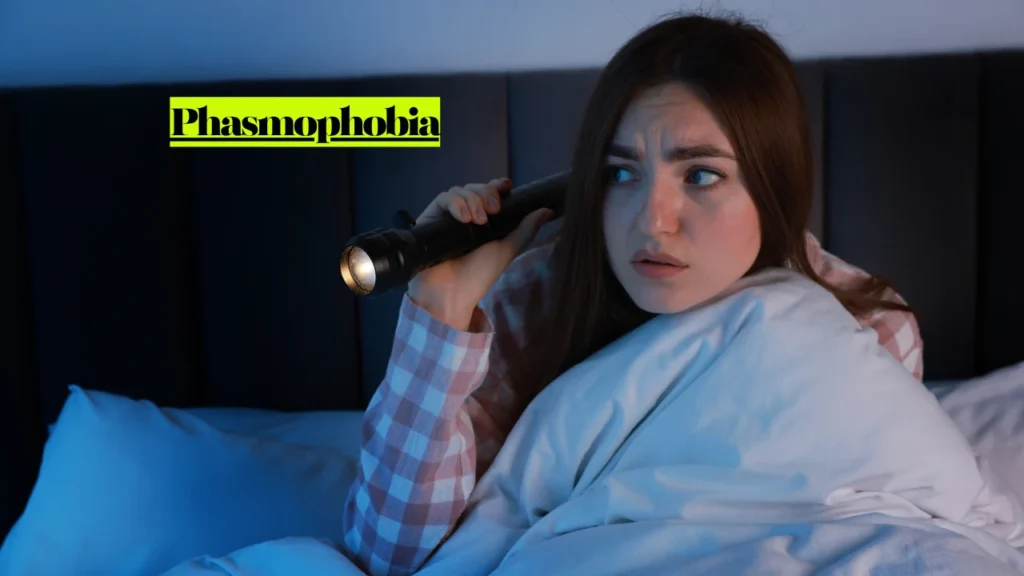
Risk Factors
Family History and Genetics: Research indicates a genetic predisposition to anxiety disorders, with children having 2-3 times higher risk if parents have specific phobias.
Personality Traits: Higher risk factors include:
- High anxiety sensitivity (fear of anxiety sensations themselves)
- Perfectionist tendencies
- High imagination and creativity levels
- Increased susceptibility to suggestion
Environmental Factors:
- Cultural backgrounds with strong supernatural beliefs
- Exposure to frightening media at young ages
- Traumatic experiences in dark or isolated environments
- Family members who model fearful responses to supernatural themes
Cultural and Religious Perspectives on Phasmophobia
How Culture Shapes Ghost Fears
Western Perspectives: In Western cultures, ghost fears often stem from horror media, Halloween traditions, and Christian concepts of spirits and afterlife. Treatment typically focuses on rational thinking and exposure therapy, emphasizing the distinction between imagination and reality.
Eastern Traditions: Many Asian cultures have deep-rooted beliefs in ancestor spirits and supernatural entities. In Chinese culture, ghost festivals and ancestor veneration are normal parts of life, making phasmophobia treatment more complex as it must respect cultural beliefs while addressing excessive fear.
Indigenous Beliefs: Native American, African, and other indigenous cultures often view spirits as natural parts of the world. For individuals from these backgrounds, phasmophobia treatment requires careful consideration of cultural spirituality versus pathological fear.
Islamic Perspectives: Islamic culture acknowledges the existence of jinn (supernatural beings) while emphasizing protection through faith practices. Treatment approaches may integrate religious coping strategies alongside conventional therapy.
Religious Context and Treatment Considerations
Faith-Based Healing: Some individuals prefer treatment approaches that incorporate their religious beliefs, such as:
Cultural Sensitivity in Therapy: Effective treatment for phasmophobia must consider:
- Respecting Beliefs: Therapists should not dismiss cultural or religious beliefs about supernatural entities
- Adapted Approaches: Treatment may need modification to align with cultural values
- Family Involvement: Some cultures emphasize collective decision-making in mental health treatment
- Traditional Healing: Integration of traditional healing practices with modern therapy when appropriate
Language and Expression: Different cultures express fear and mental health concepts differently, requiring therapists to understand cultural communication patterns and metaphors used to describe supernatural experiences.
Comprehensive Triggers & Situations
All Major Triggers
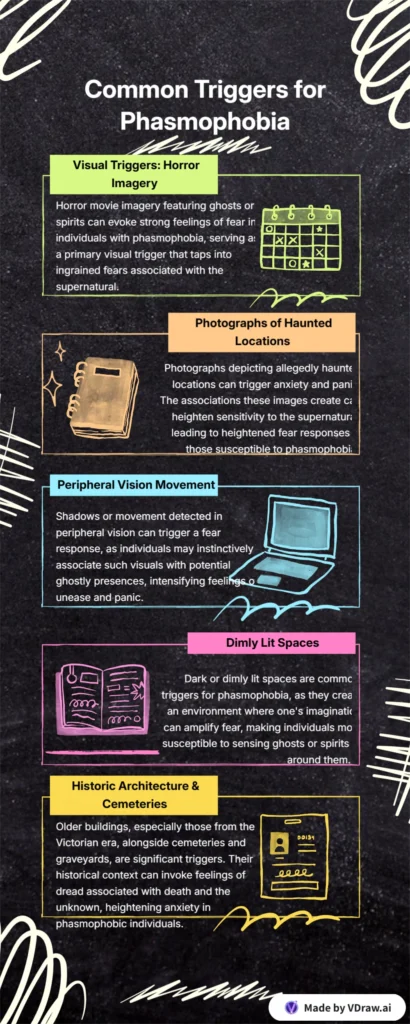
Phasmophobia triggers can be extensive and highly individual. Common triggers include:
Visual Triggers:
- Horror movie imagery featuring ghosts or spirits
- Photographs of allegedly haunted locations
- Shadows or movement in peripheral vision
- Dark or dimly lit spaces
- Older buildings, especially Victorian-era architecture
- Cemeteries and graveyards
- Mirrors in dark rooms
- Fog or mist in unusual patterns
Auditory Triggers:
- Unexplained sounds (creaking, footsteps, voices)
- Ghost stories or supernatural podcasts
- Specific music associated with horror themes
- Wind sounds, especially at night
- Old building sounds (settling, pipes, heating systems)
Environmental Triggers:
- Historic homes, hotels, or buildings
- Abandoned structures
- Basements, attics, or storage areas
- Being alone in large, empty spaces
- Cold spots or temperature changes
- Unusual electromagnetic readings (if aware of ghost-hunting equipment)
Media and Cultural Triggers:
- Supernatural television shows and movies
- Ghost documentaries or “true story” programs
- Halloween decorations and themes
- Books about hauntings or supernatural experiences
- Ghost tour advertisements or invitations
- Paranormal investigation content
Real-World Impact & Life Challenges
How This Fear Affects Daily Life
Case Example: Maria, a 28-year-old marketing professional, discovered her phasmophobia was significantly impacting her career when she couldn’t attend client meetings in a historic downtown office building. Her avoidance of the location led to missed opportunities and strained relationships with colleagues. After seeking cognitive behavioral therapy, she learned grounding techniques that allowed her to manage her anxiety and continue her career growth.
Common Life Areas Affected
Work and Career Implications:
- Job Limitations: Avoiding positions requiring work in older buildings or night shifts
- Travel Restrictions: Difficulty with business trips involving historic hotels
- Team Building: Missing company events in potentially “haunted” locations
- Productivity Issues: Distraction from intrusive thoughts about supernatural encounters
- Career Advancement: Missed opportunities due to avoidance behaviors
Relationships and Social Situations:
- Social Isolation: Declining invitations to Halloween parties or horror movie nights
- Family Tensions: Difficulty participating in family traditions or holiday activities
- Dating Challenges: Avoiding partners who enjoy supernatural entertainment
- Parenting Concerns: Anxiety about children’s exposure to age-appropriate “scary” content
- Friendship Strain: Friends may not understand the severity of the fear
Personal Activities and Hobbies:
- Entertainment Limitations: Severe restrictions on movies, books, and TV shows
- Travel Restrictions: Avoiding vacation destinations with supernatural reputations
- Home Environment: Excessive need for bright lighting, security measures, or companionship
- Sleep Disruptions: Difficulty sleeping alone or in unfamiliar environments
- Exercise Limitations: Avoiding gyms, pools, or fitness centers in older buildings
Decision-Making and Life Choices:
- Housing Decisions: Limiting home purchases to newer constructions only
- Educational Choices: Avoiding universities with allegedly haunted dormitories
- Healthcare Access: Difficulty accessing medical care in older hospital buildings
- Cultural Experiences: Missing out on historical sites, museums, and cultural events
Treatment & Recovery Options
Professional Treatment (Most Effective)
Cognitive Behavioral Therapy (CBT)
Success Rate: Cognitive behavioral therapy (CBT) is the most common therapy treatment for phobias, including phasmophobia, with success rates of 80-90% for specific phobias when completed fully.
How It Works: CBT helps you identify and challenge irrational thoughts about ghosts while developing practical coping strategies. Your therapist will help you:
- Recognize thought patterns that increase fear
- Develop realistic assessments of supernatural “threats”
- Learn relaxation techniques for managing anxiety
- Create behavioral experiments to test fearful predictions
Typical Duration: Most people see significant improvement within 12-16 sessions, with many experiencing relief within the first 6-8 sessions.
Exposure Therapy
The Gold Standard: The preferred treatment for specific phobias involves gradually exposing individuals to feared situations or stimuli related to ghosts or the supernatural.
Gradual Approach:
- Imaginal Exposure: Starting with visualizing mildly ghost-related scenarios
- Photo/Video Exposure: Viewing supernatural content in a controlled setting
- In-Vivo Exposure: Gradual visits to trigger locations with therapist support
- Virtual Reality: Some therapists use VR technology for controlled supernatural experiences
Success Rates: Studies show 75-85% of people experience significant fear reduction after completing exposure therapy programs.
What to Expect: Sessions typically involve 45-90 minutes of gradual exposure while practicing relaxation techniques. Most people complete treatment in 8-12 sessions.
Other Professional Options
EMDR (Eye Movement Desensitization and Reprocessing): Particularly effective if your phasmophobia developed after a specific traumatic experience involving supernatural fears.
Medication Options (when appropriate):
- Short-term anti-anxiety medications for severe panic symptoms during therapy
- Beta-blockers to manage physical symptoms during exposure exercises
- SSRIs may be recommended if phasmophobia occurs alongside depression or generalized anxiety
Combined Treatment Approaches: Research shows combining CBT with medication can be particularly effective for severe cases, with success rates reaching 85-95%.
Self-Help Strategies
Important Note: While self-help techniques can be beneficial, severe phasmophobia typically requires professional treatment for lasting improvement.
Breathing Techniques:
- 4-7-8 Breathing: Inhale for 4 counts, hold for 7, exhale for 8
- Box Breathing: Equal counts for inhale, hold, exhale, hold (4-4-4-4)
- Diaphragmatic Breathing: Deep belly breathing to activate the relaxation response
Grounding Exercises:
- 5-4-3-2-1 Technique: Name 5 things you see, 4 you hear, 3 you touch, 2 you smell, 1 you taste
- Progressive Muscle Relaxation: Systematically tense and release muscle groups
- Mindful Present-Moment Awareness: Focus on current reality rather than feared possibilities
Gradual Self-Exposure (with safety guidelines):
- Start with supernatural content during daytime in well-lit, familiar environments
- Begin with animated or comedic ghost content before progressing to scarier material
- Never force exposure that causes panic attacks – this can worsen the phobia
- Always have a support person available during self-exposure exercises
Remember
Recovery Statistics to Inspire Hope: Over 80% of people who complete evidence-based treatment for specific phobias experience significant improvement, with many achieving complete recovery.
Validation: Seeking help for phasmophobia is a sign of strength and intelligence, not weakness. Professional treatment exists precisely because these fears are real, treatable medical conditions.
Community Connection: You’re not alone in this struggle. Thousands of people successfully overcome ghost-related fears every year with proper treatment and support. Connect with AllThePhobias.com community for ongoing support and resources.
Immediate Coping Strategies & Resources
What You Can Do Right Now
Emergency Coping Techniques
4-7-8 Breathing Exercise (for immediate anxiety relief):
- Exhale completely through your mouth
- Inhale through nose for 4 counts
- Hold breath for 7 counts
- Exhale through mouth for 8 counts
- Repeat 3-4 cycles until anxiety decreases
5-4-3-2-1 Grounding Method (when feeling disconnected from reality):
- 5 things you can see (describe them in detail)
- 4 things you can touch (texture, temperature, weight)
- 3 things you can hear (separate each sound)
- 2 things you can smell (even subtle scents count)
- 1 thing you can taste (gum, drink, or just your mouth)
Progressive Muscle Relaxation (for physical tension):
- Tense your toes for 5 seconds, then release
- Move up through calves, thighs, abdomen, hands, arms, shoulders, face
- Hold each tension for 5 seconds, then consciously relax
- Notice the contrast between tension and relaxation
Safe Space Visualization (for overwhelming fear):
- Picture your safest, most comfortable place in vivid detail
- Include sensory details: sounds, smells, textures, temperature
- Practice accessing this mental image regularly so it’s available during anxiety
Daily Management Tools
Mindfulness Apps and Techniques:
- Headspace: Offers specific anxiety and fear management programs
- Calm: Features sleep stories and anxiety relief sessions
- Insight Timer: Free meditation options with anxiety-focused content
- DARE App: Specifically designed for anxiety and panic disorder management
Gradual Exposure Planning (with safety guidelines):
- Week 1-2: Supernatural cartoons or comedic ghost content during daylight
- Week 3-4: Mildly scary ghost stories read with others present
- Week 5-6: Brief supernatural TV shows with fast-forward option available
- Important: Never proceed if experiencing panic attacks – seek professional guidance instead
Thought Challenging Worksheets:
- Identify the thought: “There might be a ghost in this room”
- Rate anxiety level: 1-10 scale
- Evidence for: What makes you think this might be true?
- Evidence against: What logical explanations exist?
- Balanced thought: “This is an old building with normal settling sounds”
- Re-rate anxiety: Usually decreases after rational analysis
Helpful Resources
Crisis Hotlines and Immediate Help:
- National Suicide Prevention Lifeline: 988 (24/7 crisis support)
- Crisis Text Line: Text HOME to 741741
- SAMHSA National Helpline: 1-800-662-4357 (treatment referrals)
- Anxiety and Depression Association Hotline: 1-240-485-1001
Recommended Books and Educational Materials:
- “Phobias & How to Overcome Them” by Jenny Alexander
- “The Anxiety and Worry Workbook” by David A. Clark
- “Feel the Fear and Do It Anyway” by Susan Jeffers
- “Mind Over Mood” by Dennis Greenberger (CBT self-help)
Online Support Communities:
- 7 Cups: Free emotional support chat
- Anxiety and Depression Association Forum: Professional-moderated discussions
- Reddit r/Anxiety: Peer support community (moderated)
- AllThePhobias.com Community Forum: Specific phobia support network
Frequently Asked Questions
Is phasmophobia a real mental health condition?
Yes, phasmophobia is a legitimate specific phobia recognized in the DSM-5 under Specific Phobia classifications. It involves an intense, persistent fear that causes significant distress and functional impairment, distinguishing it from normal fear responses.
How common is phasmophobia?
Studies indicate that the lifetime prevalence of specific phobias around the world ranges from 3% to 15%, with supernatural fears being among the more common phobia types. While exact statistics for phasmophobia specifically aren’t available, ghost-related fears affect millions of people worldwide.
Can phasmophobia be cured?
Yes, phasmophobia can be successfully treated with evidence-based approaches. Studies show 80-90% of people experience significant improvement with proper treatment, particularly Cognitive Behavioral Therapy and exposure therapy. Many people achieve complete recovery and can engage normally with previously feared situations.
How long does treatment take?
Most people see significant improvement within 12-16 therapy sessions, with many experiencing relief within the first 6-8 sessions. The exact timeline depends on severity, individual factors, and consistent participation in treatment. Complete recovery typically occurs within 3-6 months of active treatment.
Can children have phasmophobia?
Yes, specific phobias typically appear in childhood — the average age of onset is 7 years old. Children may develop phasmophobia after exposure to frightening supernatural content, trauma, or modeling fearful responses from others. Early treatment is particularly effective in children.
Will I pass this fear to my children?
While there’s a genetic component to anxiety disorders, phasmophobia isn’t directly inherited. Children are more likely to develop similar fears through learning and modeling rather than genetics. Parents can prevent transmission by managing their own treatment and avoiding excessive accommodation of avoidance behaviors.
Can phasmophobia get worse over time?
Without treatment, phobias often maintain or worsen over time due to avoidance reinforcing the fear. Phobias tend to persist for several years, and for decades in about 10% to 30% of those who have specific phobias. However, with proper treatment, the prognosis is excellent.
What should I do if I have a panic attack?
During a panic attack: 1) Use slow, deep breathing (4-7-8 technique), 2) Practice grounding exercises (5-4-3-2-1 method), 3) Remind yourself it will pass (typically peaks within 10 minutes), 4) Move to a safe, comfortable space if possible, 5) Call a support person if needed. If panic attacks are frequent, seek professional help immediately.
Is medication necessary for treating phasmophobia?
Medication isn’t typically the first-line treatment for specific phobias like phasmophobia. CBT and exposure therapy are usually most effective. However, medication may be helpful for severe cases, when panic symptoms are overwhelming, or when other anxiety disorders are present alongside the phobia.
Can virtual reality help treat phasmophobia?
Yes, some therapists use Virtual Reality Exposure Therapy (VRET) for specific phobias. This allows controlled exposure to supernatural scenarios in a safe therapeutic environment. Research shows VR can be as effective as traditional exposure therapy while offering more control over the exposure experience.
How do I know if my fear is severe enough to need professional help?
Seek professional help if your fear: causes panic attacks, significantly impacts work/relationships/daily activities, leads to complete avoidance of necessary situations, causes sleep problems lasting more than two weeks, is getting worse rather than better, or includes physical symptoms like chest pain or difficulty breathing.
What’s the difference between being scared of ghosts and having phasmophobia?
Normal fear involves temporary discomfort that doesn’t significantly impact daily life. Phasmophobia involves persistent, excessive fear lasting 6+ months that causes significant distress and functional impairment. People with phasmophobia often recognize their fear is excessive but can’t control it without treatment.
Take Action: Your Path to Recovery
If you recognize yourself in this description of phasmophobia, remember that effective help is available. Thousands of people successfully overcome supernatural fears every year through evidence-based treatment.
Ready to Take the First Step?
Find qualified therapists specializing in anxiety disorders and specific phobias through:
- Psychology Today directory (filter for “phobias” and “anxiety”)
- Your insurance provider’s mental health directory
- AllThePhobias.com therapist finder tool
- Referrals from your primary care physician
Emergency Support Available 24/7:
If you’re experiencing severe anxiety, panic attacks, or thoughts of self-harm:
- Call 988 for immediate crisis support
- Text HOME to 741741 for crisis text support
- Contact your local emergency room for severe physical symptoms
Citations and Sources
- The Lancet Psychiatry (2018). “Specific phobias prevalence and treatment outcomes.” Vol. 5, Issue 8.
- Healthline Medical Review (2019). “Cognitive behavioral therapy effectiveness for phasmophobia treatment.”
- Medical News Today (2024). “Phasmophobia: Causes, symptoms, and treatment approaches.”
- American Anxiety and Depression Association (2024). “Physical symptoms of specific phobias.”
- DSM-5 Diagnostic and Statistical Manual (2022). “Specific Phobia diagnostic criteria.”
- Journal of Anxiety Disorders (2023). “Treatment efficacy rates for specific phobias using CBT.”
- National Institute of Mental Health (2024). “Specific phobia statistics and prevalence data.”
- Wikipedia Contributors (2025). “Specific phobia lifetime and annual prevalence rates.”
This article was created by the expert content team at AllThePhobias.com. Information is for educational purposes only and should not replace professional medical advice. Always consult with qualified mental health professionals for diagnosis and treatment.
Last Updated: October 2025
